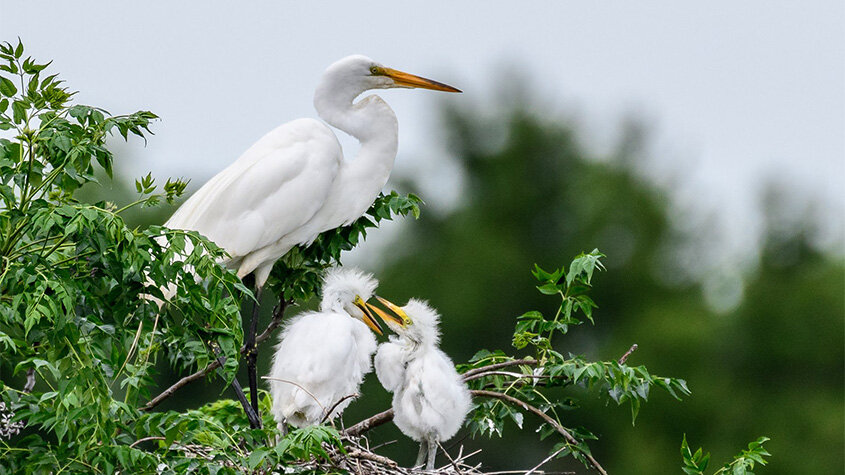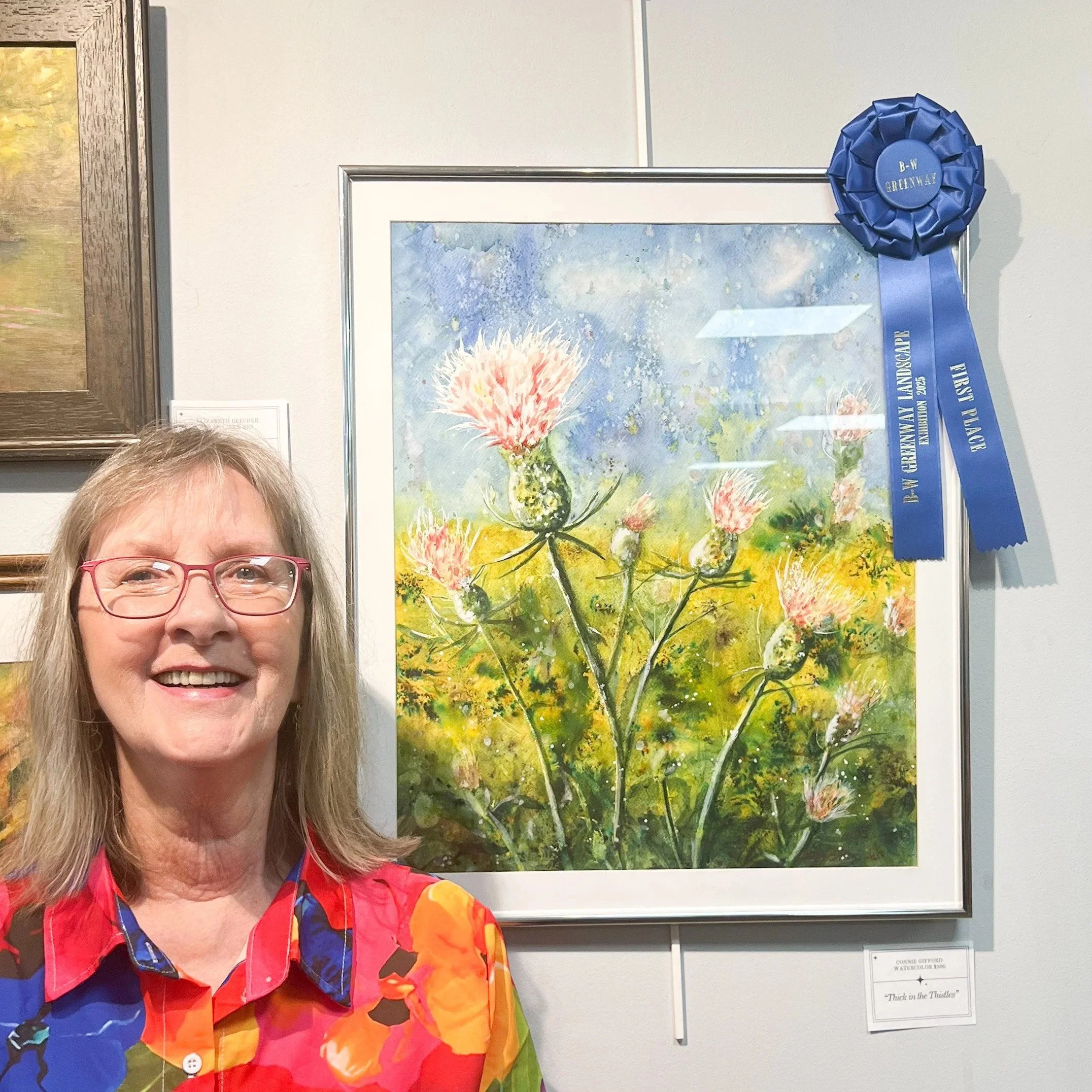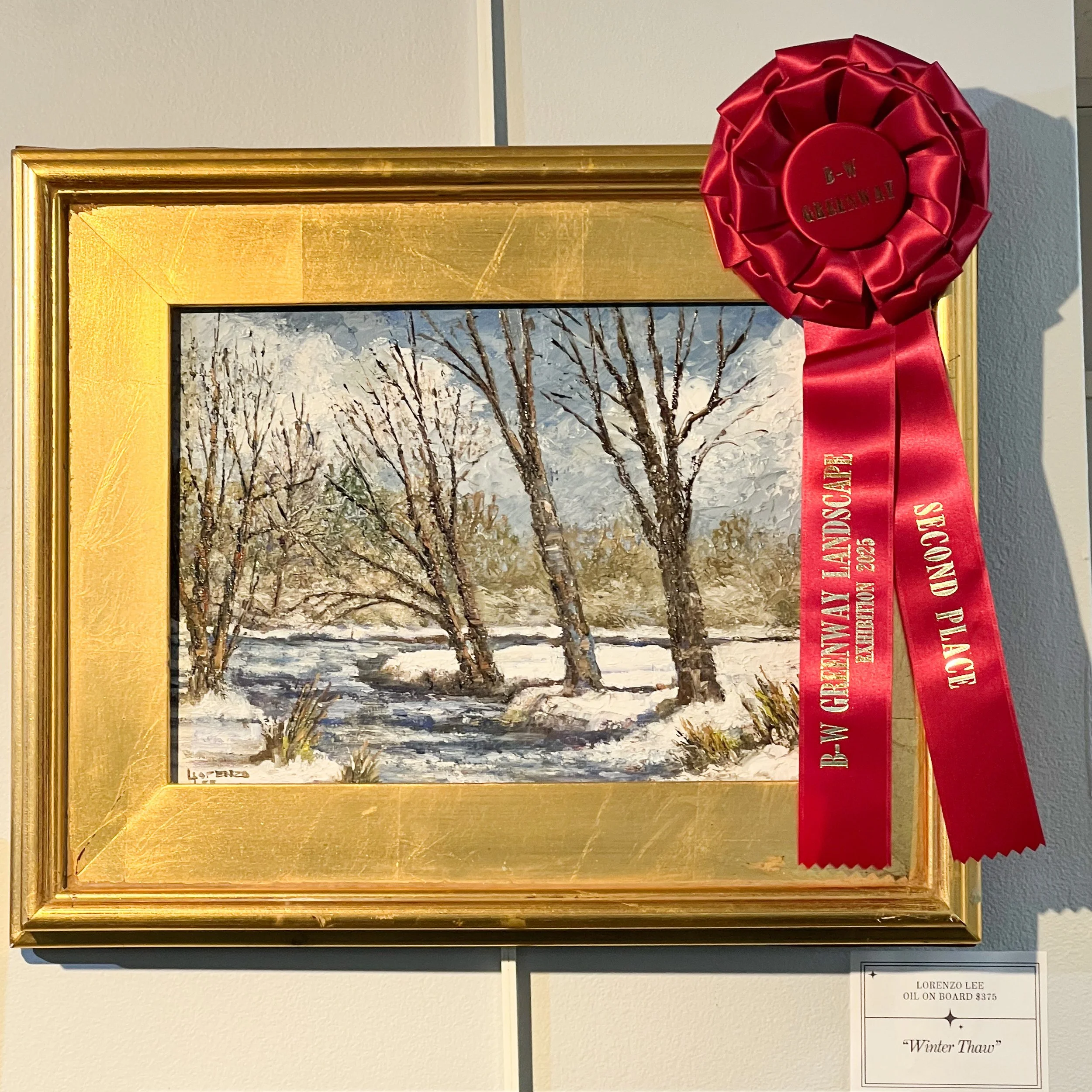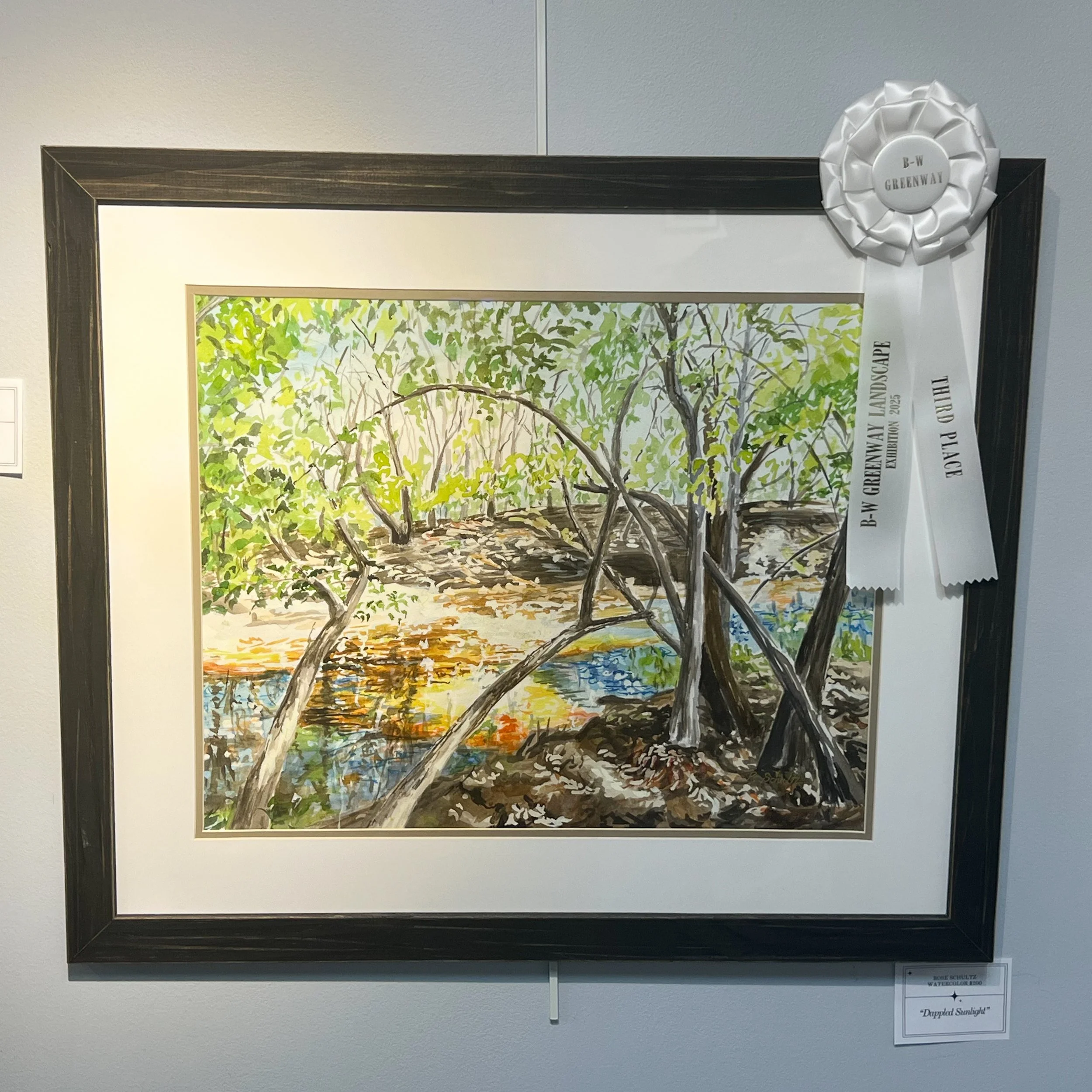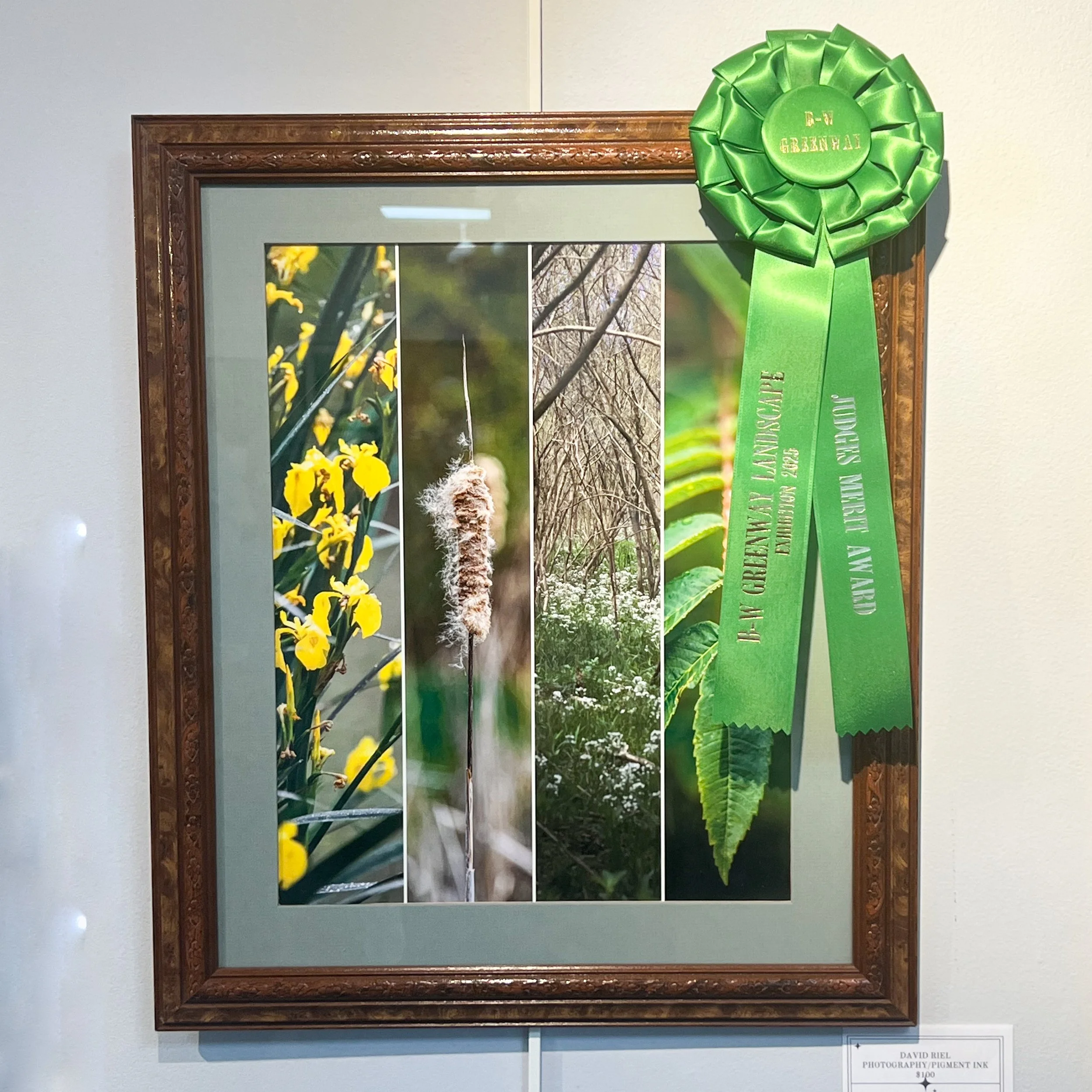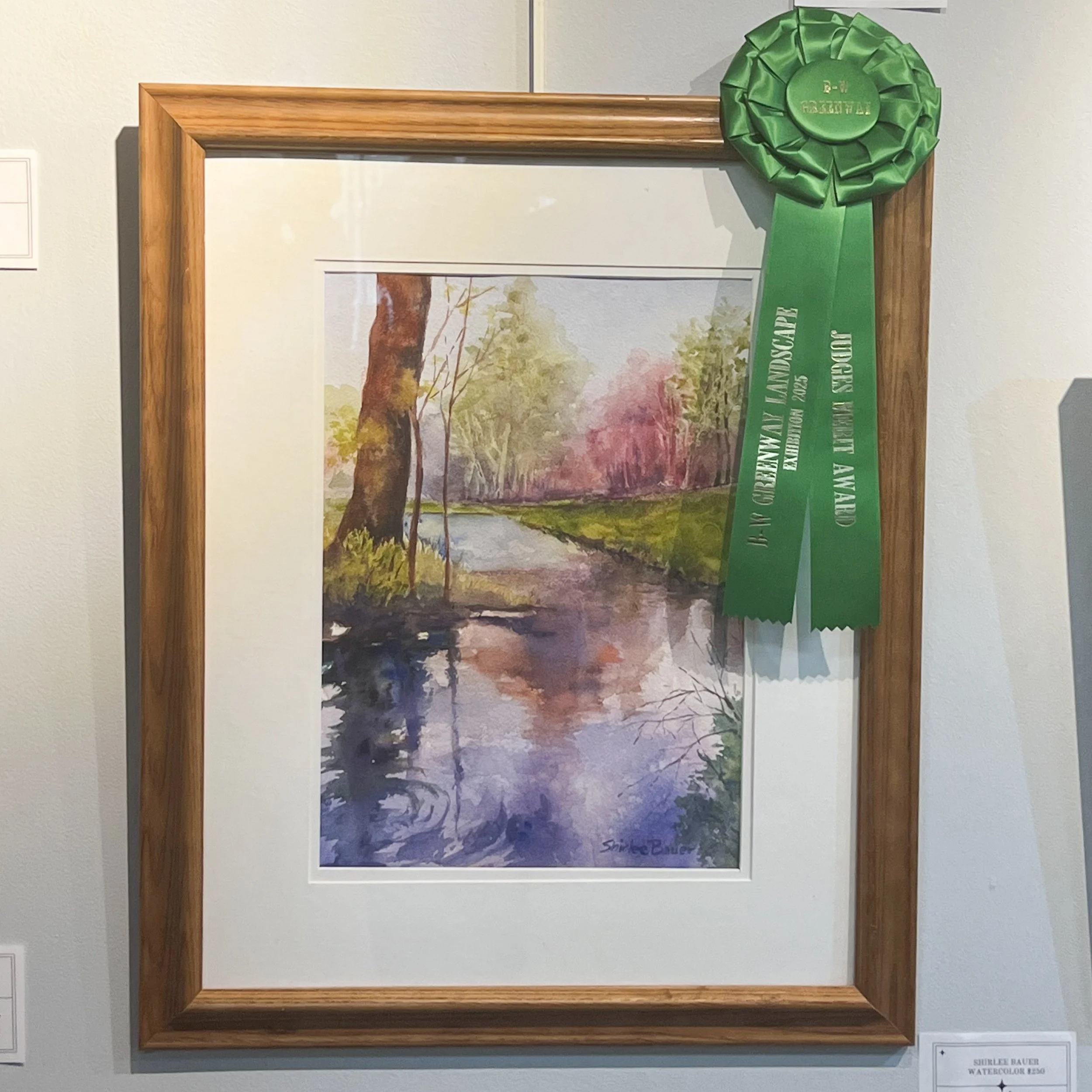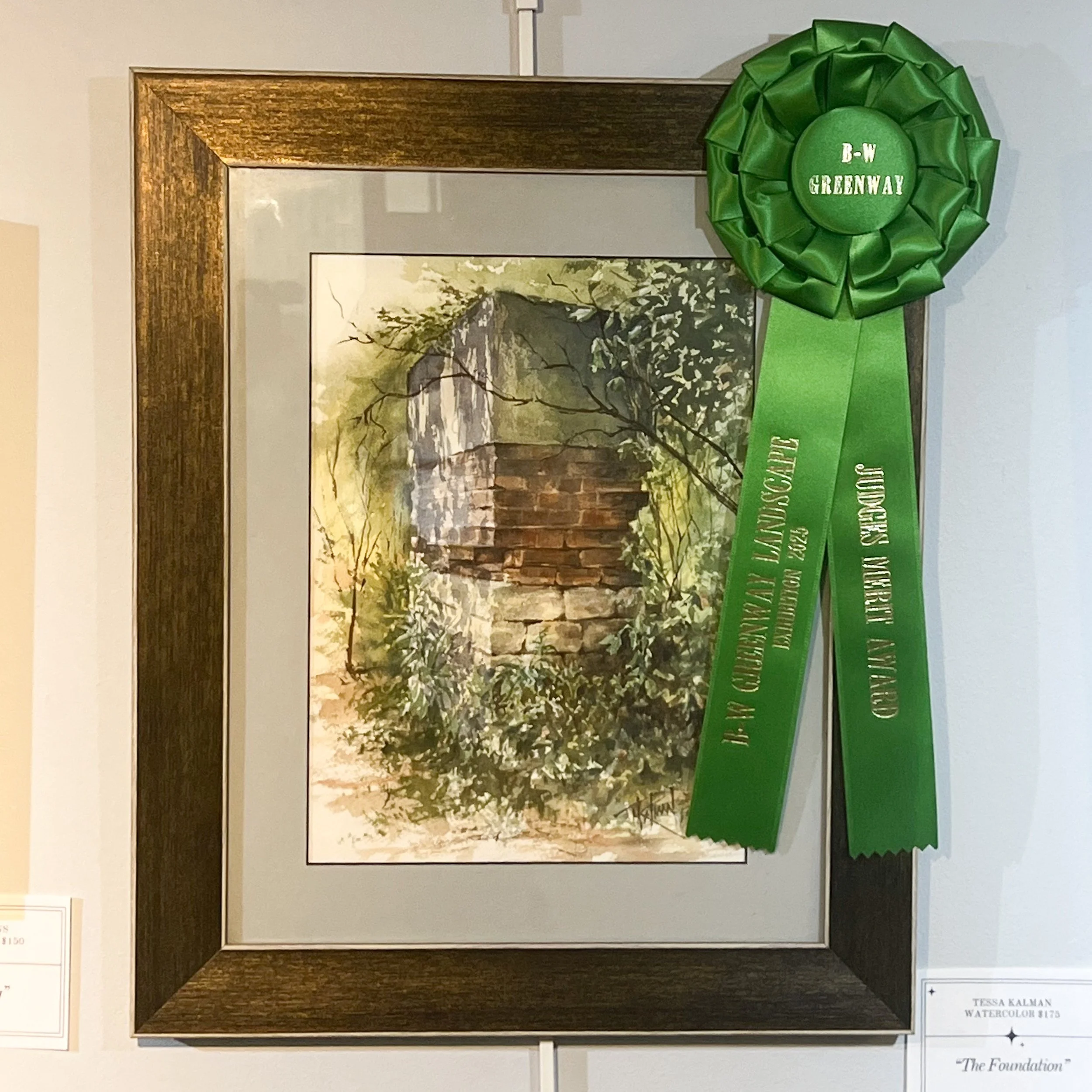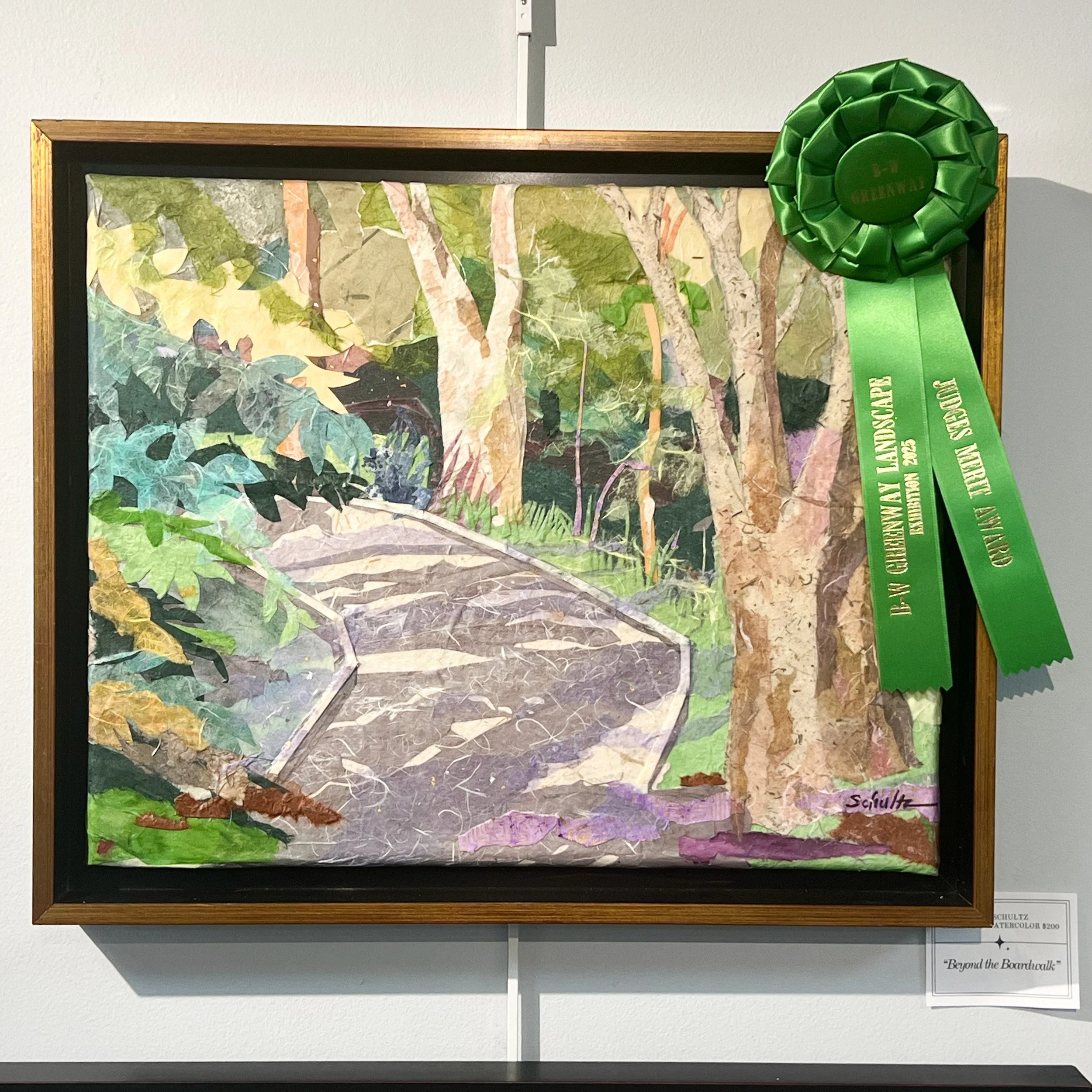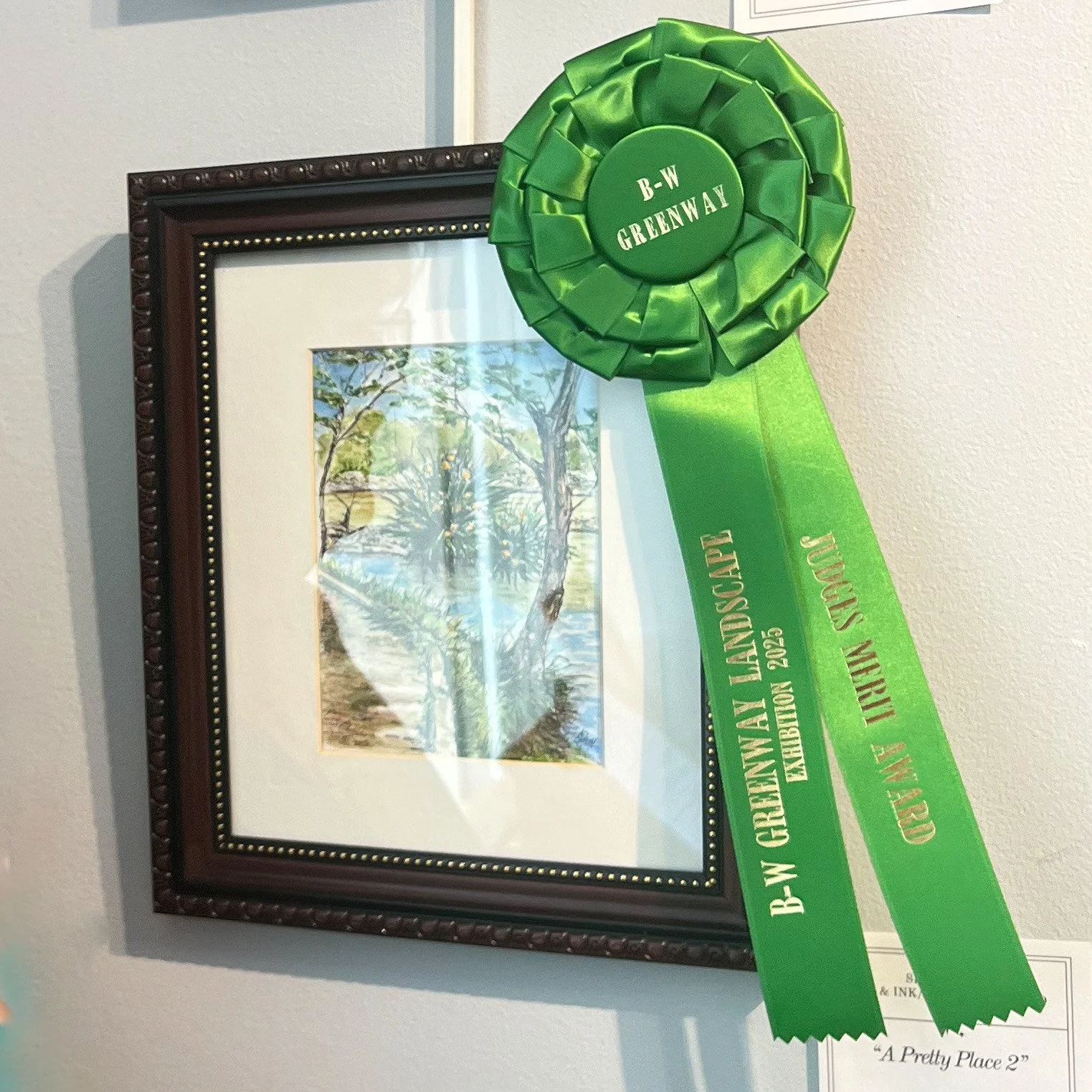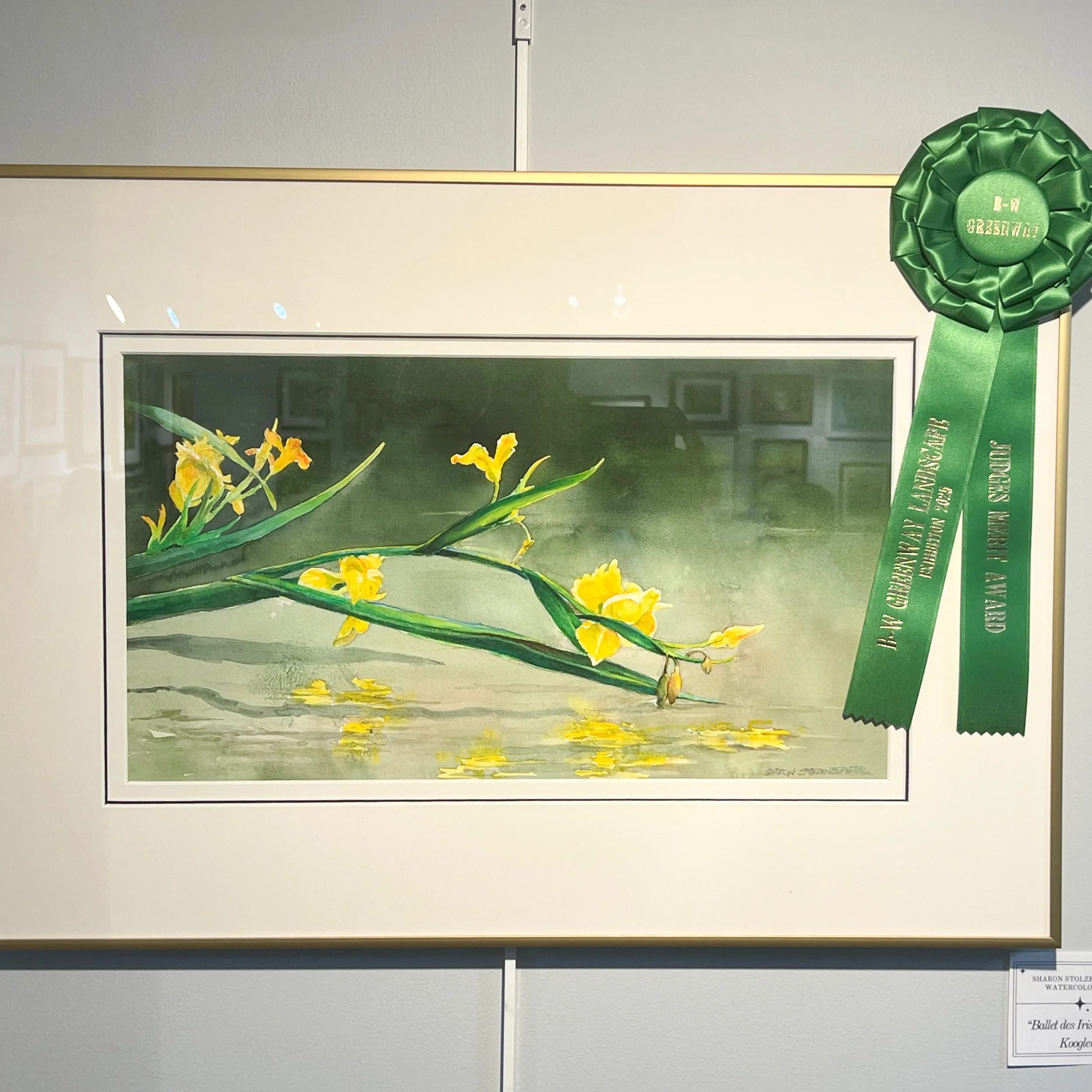Thriving planet.
THRIVING PEOPLE.
Juried Art Landscapes2025, B-W Greenway Community Land Trust and Fairborn Art Association: We would like to thank everyone that participated and volunteered in this event. Slideshow by Lori Common, 91 pieces of artwork this year!
1st Place: Connie Gifford “Thick in the Thistles”. 2nd Place: Lorenzo Lee “Winter Thaw”. 3rd Place: Rose Shultz “Dappled Sunlight”
Honorable Mention: Shirlee Bauer “Signs of Autumn”, Marsha Elliot “The Foundation”, A. Shay Mead “A Pretty Place 2”, David Riel “Koogler Reserve: Take a Closer Look”, Julia Roberts “Watcher”, Rose Shultz “Beyond the Boardwalk”, Sharon Stolzenberger “Ballet des Iris Chez Le Koogler”
People’s Choice: Paige Warren “Arcaea Koogler”
Pictures taken by Lori Common
Nature Talk by Nancy Bain
Birdsong
A week or so ago, a friend and I were walking through a nature preserve and without using our binoculars, we could identify nearly a dozen birds. We heard caw, caw; Chickadee-dee-dee; teacher, teacher; chirp, chirp; jay, jay; peck, peck; peck, peck, peck; shriek, shriek. All around us was birdsong—percussive, lyrical, loud, soft, rhythmic, and, in a strange way, harmonious. I heard it as Nature’s all-encompassing energy in the form of music. I felt invigorated and connected. And that brought to mind three questions: What is music? Why is there music? And is it possible to wipe out music? (N.B. - this last being a variation of a perplexing question, why is there something rather than nothing?)
First, Merriam-Webster defines music as “the science or art of ordering tones or sounds in succession, in combination, and in temporal relationship to produce a composition having unity and continuity.” Second, I say birdsong is the essence of music. From Nature’s design, musicians can find variety and complexities. Birdsong also brings us, not separation, but relationship with the world and its creatures. Research finds that music affects all parts of the brain and nervous system that modulates our heart rate, breathing, digestion, or blood pressure. Thus, Nature aims to maintain homeostasis. All these physical responses—even if it’s for just a moment—point to the sense that we have value and are at one with the world. Birdsong does that and gives meaning to Thoreau’s statement, “Be it life or death, we crave only reality.” Reality is consciousness. Therefore, Nature’s music, especially birdsong, is consciousness.
But why is there music? Exploring birdsong, we find many emotional evocations. A Killdeer stirs up maternal instincts and respect for a small creature that fights for her progeny crying out its namesake alarm to distract a predator too near the bird’s nest. Birdsong can make us laugh. How the call can fool us—a Blue Jay imitating, say, a Cooper’s Hawk to scare away other birds from a possible food source. A Northern Mockingbird’s birdsong brings awe. Geesh, these guys can mimic 200 or more different sounds, including car horns, revving motorcycles, and ambulance sirens! And then there’s the Barred Owl terrifying us in the dark of night, even though we know the animal is harmless to us. From the highest plane and forest depths, the Wood Thrush lifts us with unfathomable spirituality. Ah! That haunting, watery, lyrical trill. How is it this creature can sing two different notes at the same time? This answers the why of music —in birdsong Nature nurtures human conscience with the best kind of values.
The last question is tricky. If music is interpreted as just sound, no, it’d be impossible to wipe out music. I think of jazz, heavy metal, and rap genres that I cannot connect with, but others do. I think of Buzz Aldrin, the second person to walk Earth’s Moon, who found passion there, describing the celestial body’s terrain as “magnificent desolation”—silence, a sound echoing eternity.
But could Homo sapiens wipe out birdsong? Now that is possible. Studies find that, in the last 50 years, North American birds have declined by nearly 50%. Even birds such as the nonnative House Sparrow, with its bland and low-frequency chatter, has declined by 52%. A chilling omen comes from 19th Century, during which hunters and other consumers wiped out billions of Passenger Pigeons in just 50 years. Does it matter to pursue the saving of birdsong? Homo sapiens may exist for perhaps thousands or millions of years. And Planet Earth will keep turning for billions no matter what we do or don’t do. But how heartbreaking it is to think of living in Creation where no birds sing.
I asked my birding friend, what do you think about when you listen to birdsong? She replied, “My thinking pauses, and I feel all the goodness of nature, and I am filled with happiness.”
27th Annual Meeting
We would like to thank everyone that attended last night’s 27th Annual Meeting. Thank you to Jennifer Windus our featured speaker, thank you to Chris Bingman for the music, and thank you to everyone that donated snacks that helped make this event possible. We would also like to congratulate Pat and Mike Higgins, and Richard Swigart (in memorium), our Green Heart Awardees.
Another Wetland Preserved in Perpetuity
On October 25, Jennifer and Grant Brown signed a Conservation Easement (CE) on their five acre wetland area south of Fairfield Yellow Springs Road. The site includes a Category 2 wetland and a tributary to Hebble Creek. It is strategically located within a mile of Pearl’s Fen and across the road from the Doorley Fen, both of which are category 3 wetlands.
75% of the CE acquisition cost was funded by the Clean Ohio Fund. The Brown’s donated the remaining 25%. The Browns will also fund the planting of prairie grass on the southwest corner of the parcel. Kaitlin Montag, our Baseline Editor, will prepare a Current Condition Report once the prairie is planted. As with all the properties we’ve preserved, there will be an annual monitoring to take photos and write a narrative of the natural condition of the parcel. We will also add this property to our legal defense policy with Terra Firma. B-W Greenway Community Land Trust has now protected 26 properties totaling 730 acres.
Introducing Brad Kerry
Brad Kerry is an advocate for sustainable development, habitat restoration, and community action. He works for the City of Fairborn's Planning Department, where he brings data-driven insight and strategic vision to local policy and land use planning. Brad holds a master's degree in economics and a bachelor's degree in mathematics and Statistics, combining analytical expertise with a passion for community impact. He also serves as the Director of Government Affairs for Dark Sky Ohio, promoting responsible lighting policies across the state, and is the Chair of Research for the B-W Greenway, where he will help guide conservation and ecological research efforts in the region
B-W Greenway and BIOWISE
Biotic Inventories of Wetlands in Sensitive Environments, the BIOWISE Project, is a new effort by B-W Greenway that was recently funded by the Greater Dayton Conservation Fund. The goal of BIOWISE is to determine whether species in the upper B-W Greenway are increasing, stable, or in decline. To further this objective, BIOWISE is gathering together existing baseline data and combining them with new inventories to establish trend lines and to fill existing gaps. The project is performing a technique called cover mapping in wetland areas along the Mad River. Already, participants have been surprised at the wide diversity of plant and animal species, and future effort promises exciting new findings.
B-W Greenway Community Land Trust
info@bwgreenway.org, www.bwgreenway.org, 937-867-5212
Board of Trustees: Bob Jurick, President; Sarah Wallentine, Vice President and Secretary; Jim Byrd , Treasurer; Tom Duffee, Board Chair and Chief Steward; Eric Borth, Katy Buddelmeyer, Michael Cox, Audrey Heiser, Trevor Martin, and Brad Kerry.
Administrative Coordinator: Heidi Geron, admin@bwgreenway.org
Baseline Editor: Kaitlin Montag, baseline@ bwgreenway.org
Financial Assistant, Sherry Li Cai
Food and Farming Team: Audrey Heiser, food@bwgreenway.org
GIS Consultant: Carol Manda, gis@bwgreenway.org
Land Conservation Projects Team: Bob Jurick, projects@bwgreenway.org
Land Stewardship Coordinator: Heidi Geron, land@bwgreenway,org
Land Stewardship Team: Tom Duffee, chiefsteward@bwgreenway.org
Newsletter Editor: Katy Buddelmeyer, editor@bwgreenway.org
Research Team Chair: Brad Kerry, research@bwgreenway.org
What is a Land Trust?
A Land Trust permanently protects natural areas by partnering with landowners to place conservation easements on their properties. A conservation easement gives legal assurance that the property's natural quality will be preserved in perpetuity.
Mission: To protect and restore the land and water resources between the Beaver Creek and Wenrick Wetlands while balancing human needs with those of the natural environment.
Vision: A lasting corridor of green spaces that protect and enhance the natural and agricultural resources supported by a community working together.

